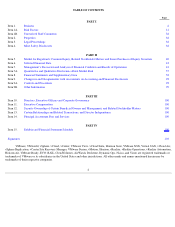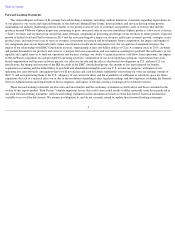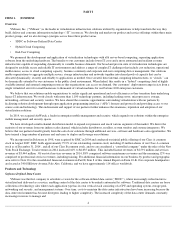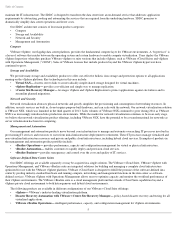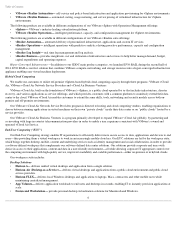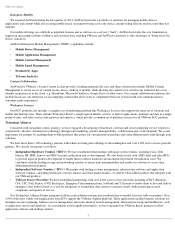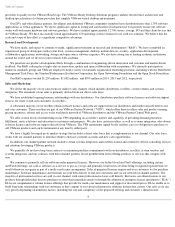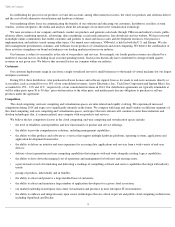VMware 2014 Annual Report Download - page 14
Download and view the complete annual report
Please find page 14 of the 2014 VMware annual report below. You can navigate through the pages in the report by either clicking on the pages listed below, or by using the keyword search tool below to find specific information within the annual report.
Table of Contents
The risk factors that appear below could materially affect our business, financial condition and results of operations. The risks and
uncertainties described below are not the only risks and uncertainties facing us. Our business is also subject to general risks and uncertainties that
affect many other companies. Specific risk factors related to our relationship with EMC are also included below.
Risks Related to Our Business
As the markets for our server and desktop virtualization products have matured we have been increasingly developing and marketing
products and services targeted toward the delivery, management and automation of information technology (
“IT”) infrastructure, platforms
and services through cloud-based solutions. If businesses do not find our cloud computing solutions compelling, our revenue growth and
operating margins will decline.
Our products and services are based on server virtualization and related technologies that have primarily been used for virtualizing on-
premise data center servers and form the foundation for private cloud computing. As the market for data center server virtualization has matured,
we have increasingly directed our product development and marketing toward products and services that enable businesses to utilize
virtualization as the foundation for cloud-based computing. We have extended the benefits of virtualization beyond servers to include network
and storage, and coupled this with management and automated delivery of IT resources to create private cloud platforms. We have also extended
our product portfolio beyond desktop virtualization to include mobile device management with our AirWatch offerings. We also offer hybrid
cloud services through our vCloud Air platform.
Our success depends on our current and future customers perceiving technological and operational benefits and cost savings associated with
the increasing adoption of our private and hybrid cloud solutions as well as our client virtualization and mobile device management solutions. As
the market for our server virtualization products matures and the scale of our business increases, our rate of revenue growth will depend largely
upon the success of our newer product and service offerings. In addition, to the extent that our newer private and hybrid cloud solutions, as well
as our client virtualization and mobile device management solutions are adopted more slowly or less comprehensively than we expect, our
revenue growth rates may slow materially or our revenue may decline substantially.
The large majority of our revenues have come from our server virtualization products including our flagship VMware vSphere product line.
Decreases in demand for our server virtualization products could adversely affect our results of operations and financial condition.
The large majority of our revenues have come from our server virtualization products. Although we continue to develop other applications
for our virtualization technology such as our network virtualization solution, VMware NSX, end-user computing products and hybrid cloud
services and expand our offerings into related areas such as our vRealize SDDC management products and vCloud product suites, we expect that
our server virtualization products and related enhancements and upgrades will constitute a majority of our revenues for the foreseeable future.
Declines and variability in demand for our data center virtualization products could occur as a result of:
Also, as more and more businesses achieve the virtualization of their servers, certain markets for our VMware vSphere product line have
matured. Our sales of standalone VMware vSphere have declined as a portion of our overall business as we seek to transition our customers to
product suites, our newer products and infrastructure-as-a-
service offerings. If we fail to introduce compelling new features in future upgrades to
our VMware vSphere product line, manage the transition to hybrid cloud platforms, develop new applications for our virtualization technology
or provide product suites based on the VMware vSphere platform that address customer requirements for integration, automation and
management of their IT systems, overall demand for products and services based on VMware vSphere may decline.
Due to our product concentration, our business, financial condition, results of operations, and cash flows would therefore be adversely
affected by a decline in demand for our data center virtualization products.
12
ITEM 1A.
RISK FACTORS
•
improved products or product versions being offered by competitors in our markets;
•
competitive pricing pressures;
• failure to timely execute and implement our product strategy, which could lead to quality issues, integration issues with ecosystem
partners, and difficulties in creating and marketing suites of interoperable solutions;
•
failure to release new or enhanced versions of our server virtualization products on a timely basis, or at all;
• technological change that we are unable to address with our server virtualization and private cloud products or that changes the way
enterprises utilize our products; and
•
general economic conditions.


